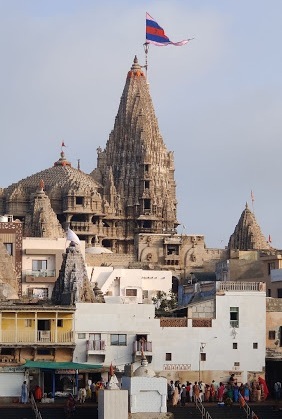
Dwarka is an ancient city in the northwestern Indian state of Gujarat. It’s known as a Hindu pilgrimage site. It is known as the city where Sri Krishna set up a beautiful golden city and ruled for more than 100 years before that city was taken over by the sea.
Nearest airport where regular flights are there to rest of India, is Rajkot airport. I flew there from Bangalore on a direct Spicjet flight which took around 2.5 hours. From there it is a road journey of 4-4.5 hours via Jamnagar. If you are coming from Mumbai, check for direct flights to Jamnagar too, which is just 2 hours away from Dwarka.
The main draw for tourists coming to Dwarka, the Dwarkadhish Temple (Jagat Mandir), is believed to have been established more than 2500 years ago by Lord Krishna’s great grandson, Vajranabh. The ancient temple has been renovated several times, especially leaving imprints of 16th and 19th centuries. The temple stands on a small hill accessed by 50 plus steps, with heavily sculptured walls that cocoon the sanctum with the main Krishna idol.
This is a picture of lord Dwarkadish being offered 56 different types of offerings, also known as Chappan Bhog. The temple itself has a fascinating legend. The original structure was destroyed by Mahmud Begada in 1472, and subsequently rebuilt in the 15th-16th century. It was also feted by Adi Shankaracharya, the 8th century Hindu theologian and philosopher.
Sudama Setu is dedicated to the name of Sant Sudama who was a great friend of Shri Dwarkadhish. This is a newly built suspension pedestrian Bridge over the Gomti river. Which connects Island to the mainland where temple of Shri Dwarkadhish is situated.
On the other side of the bridge there is awesome Dwarka Beach with Pristine blue colour water. From there you can also have the amazing memerizing view of Dwarkadhish Temple and Gomti Ghat along with City. Camel ride and bike ride are good to enjoy in the beach.
The Samudra Narayana Temple is located at the confluence of the river Gomti and the Arabian Sea. The temple is dedicated to Goddess Gomti who is believed to have been brought from heaven by Rishi Vasishtha to sanctify Rama after his battle with Ravana. After purification of Rama, Goddess Gomti manifested here on the ghats and got submerged into the Arabian sea.
Located relatively on the outskirts, the Rukmini Mata Temple commemorates Lord Krishna’s queen. The temple is said to be more than 2500 years old but it may have been reconstructed over time. The present temple is said to belong to the 12th century. It is much more modest than Dwarkadhish in structure and sculptures but inspires the same devotional fervour. Carvings of gods and goddesses embellish the exteriors and the main idol of Rukmini is housed in the sanctum. Carved naratharas (human figures) and gajatharas (elephants) feature in the panels at the base of the platform.
A small island off the coast of Dwarka and accessed via Okha is home to the namesake temple, and supposedly the residence of Lord Krishna when he arrived here. The establishment of the temple is credited to Guru Vallabhacharya. Apart from the main temple, others in the complex commemorate Hanuman, Vishnu, Shiva, Lakshmi Narayan, Jambavati, Devi and others.
Bet Dwarka, also known as Shankhodhar, is said to have been the residence of Lord Krishna during his ruling years at Dwarka. It derived its name from the word ‘bet’ which translates to ‘gift’ and is believed that Lord Krishna received it from his friend Sudama. In the ancient epic, Mahabharata, Bet Dwarka is known by the name of ‘Antardvipa’ to which people of the Yadava clan needed to travel by boat. Explorations and excavations carried out under the sea have revealed the presence of settlements whose age can be traced back to the era of the Harappan civilisation and that of the Mauryan rule.
Nageshwar Jyotirlinga is home to one of the 12 jyotirlingas (self-manifested shivalinga) in India. The red building lies at a short distance from the town. Legend goes that it was here that a demon called Daaruka imprisoned a Shiva devotee called Supriya. The chants of ‘Om Namaha Shivay’ by Supriya invoked Lord Shiva who arrived here and vanquished the demon. A self-manifested Shivalinga appeared here and is prayed to this date.
If you wish to try local cuisine, try an amazing Kathiyawadi meal at Srinathji Dining Hall in the main city of Dwarka. It is famous for thali which has 4 curries, 8 pickles, 4 salads, jowar roti, phulkas, buttermilk, papad, dal rice – all unlimited just for Rs.130 per head!
No wonder there’s a huge rush any day of the week and you have to wait minimum of 1-1.5 hours but the wait is worth it for the taste! Protip – pre-book your table and spend 1hour roaming around before coming back for your meal.
Enjoyed a beautiful sunset at Shivarajpur Beach which is 11 km away from Dwarka and recently received the globally recognized Blue Flag certification, an eco-label accorded by an international agency ‘Foundation for Environment Education’, Denmark. Blue Flag beaches are considered the cleanest in the world.
The best time to visit Dwarka in Gujarat is between November and February, and during Janmashtami which is celebrated grandly here. Visiting hours at the main temple are 7am–12.30pm and 5–9pm. Darshan will take minimum of 2-3 hours, account for double the time during full moon days.
